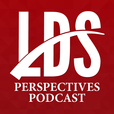
Summary: The Interview: In this episode of the LDS Perspectives Podcast, Laura Harris Hales interviews Mark Ashurst-McGee, a co-editor of a new book, Producing Ancient Scripture: Joseph Smith’s Translation Projects in the Development of Mormon Christianity.<br> <br> <br> <br> The Book of Mormon is well known, but there were several subsequent texts that Joseph Smith translated after the Book of Mormon. This collaborative volume is the first to provide in-depth analysis of each and every one of Joseph Smith’s translation projects. The compiled chapters explore Smith’s translation projects in focused detail and in broad contexts, as well as in comparison with one another. The various contributors approach Smith’s sacred texts historically, textually, linguistically, and literarily to offer a multidisciplinary view.<br> <br> <br> <br> While most of the contributors are Latter-day Saints, not all are. From its inception, the book was meant to be a scholarly work that anyone could read and engage in—whether a member of the Church of Jesus Christ of Latter-day Saints or from any other branch of the Restoration or any denomination of Christianity or any other faith or no faith. Due to this intentional editorial decision, there is nothing in the book asserting or excluding supernatural involvement. The various translation projects are studied not in terms of the ancient origins they claim for themselves but rather in terms of their translation into English by Joseph Smith in the modern age.<br> <br> <br> <br> Here is a brief overview of the comprehensive coverage provided in the book:<br> <br> <br> <br> A chapter by religious studies scholar Christopher James Blythe examines Joseph Smith’s translation projects broadly within the Christian tradition of spiritual gifts, especially the gifts of speaking in tongues and the interpretation of tongues.<br> <br> <br> <br> A chapter by literary scholar Jared Hickman compares Smith’s teachings about the “translation” of scripture and the “translation” (bodily transfiguration and ascension) of prophets such as Enoch and Elijah, showing how these two types of translation are related.<br> <br> <br> <br> A chapter by historian Michael Hubbard MacKay investigates Joseph Smith’s earliest efforts toward translation, when he transcribed characters from the golden plates and sent a transcript thereof with Martin Harris to have it translated by prominent scholars like Samuel Mitchill and Charles Anthon.<br> <br> <br> <br> A chapter by scholars Amy Easton-Flake and Rachel Cope shows how Emma Hale Smith, Mary Musselman Whitmer, and other women made Joseph Smith’s translation work possible and how they took on the roles of witnesses to the golden plates and their translation.<br> <br> <br> <br> A chapter by scholarly writer Samuel Morris Brown investigates what the Book of Mormon has to say about the method of translation and related forms of scriptural generation.<br> <br> <br> <br> A chapter by religious studies scholar Ann Taves compares Joseph Smith and the “translating” of the Book of Mormon with Helen Schucman and the “scribing” of A Course in Miracles—another long and complex religious text produced within a relatively short period of time.<br> <br> <br> <br> A chapter by historian Richard Lyman Bushman explores how the Book of Mormon has a heightened and unusual awareness of its own construction as a book. It also considers how the early American history and culture of books and bookmaking may have influenced the way people understood this and other translation projects.<br> <br> <br> <br> A chapter by historian and comparative religion scholar Grant Hardy explores the similarities and differences between the Book of Mormon and Joseph Smith’s “thus saith the Lord” genre of commandments and other revelations (like those found in the Doctrine and Covenants), along with giving special attention to the rhetorical effect of...
